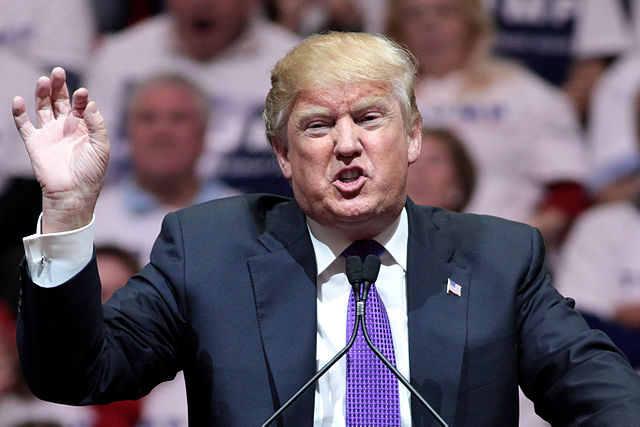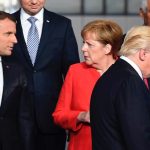by Kaveh L. Afrasiabi
President Donald Trump has roiled both the Middle East and the American foreign policy establishment with the startling announcement that he is withdrawing U.S. forces from Syria. That decision, prompting the resignation of Secretary of Defense James Mattis, has also disquieted America’s allies, with French President Emmanuel Macron expressing his deep disapproval and vowing to continue the token French military presence in eastern Syria.
As expected, this decision—which harkens back to Trump’s 2016 campaign promises—has elicited a wide range of reactions, from vehement denunciation to mild approval to solid defense. Opponents of Trump’s decision have focused on its potential implications with respect to the unfinished business of fighting the Islamic State (ISIS or IS) as well as containing Iran, with many pundits branding the decision a victory for Tehran. Case in point., Ranj Alaaldin at Brookings Institution has asserted that “Withdrawing will help Iran strategically, giving it more space to pursue its long-sought land bridge linking Tehran to Beirut and the Mediterranean, for instance. Overall, the U.S. pull-out will have reverberations throughout the region, tilting the regional balance of power further in Iran’s favor.”
On the opposite side, Stephen Walt has forcefully defended the decision as “the right thing in the wrong way.” A champion of the kind of back to the past U.S. “offshore balancing” that gained prominence during the Nixon presidency, Walt feels vindicated by Trump’s decision over a country that in his opinion has little or no vital strategic value to the U.S. and is, indeed, an economic liability to the winning coalition, including Russia and Iran. Other experts are not as certain—for example, Robert Hunter has raised interesting questions as to whether or not this decision is indicative of a larger transformation in the edifice of U.S. foreign policy. This question owes itself partially to the reports that Trump is also considering pulling troops out of Afghanistan–though he’s apparently issued no orders to that effect–while simultaneously pursuing a dialogue with Taliban and a cease-fire in war-torn Yemen.
The Syria decision can reasonably be interpreted–particularly if the reports of an Afghanistan withdrawal are true–as a sign of mid-course evolution by a nationalistic president whose “America First” ethos has involved using pressure tactics against allies over burden-sharing and free-riding, nowadays extended beyond NATO and including regional allies such as Israel and Saudi Arabia. Trump seems to be restructuring America’s post-World War II alliance politics, though not, as claimed by some of Trump’s foreign policy critics, in ways that are anti-alliance or isolationist. Rather, the Syria withdrawal decision evinces a conceptual break from the pattern of U.S. foreign policy stretching back decades. It shows the traces of a post-interventionist paradigm of foreign policy behavior that is epitomized by the rhetoric that the U.S. ‘is not the policeman of the world.’ Although an incremental decision affecting a token military presence, the decision has far-reaching consequence by virtue of the logic of action marking the end of an era of wars of choices–“we will not be suckered any more.”
Yet, the re-orientation toward a new, post-interventionist U.S. foreign policy is problematized by, among other things, the uneasy coexistence with a maximalist Iran policy that has extended to the arms-twisting of recalcitrant states to abide by the U.S.-imposed sanctions regime. In turn, this calls for a relational view of foreign policy decisions, instead of viewing them in isolation.
The Relational View of Trump’s Syria, Turkey, and Iran Decisions
Indeed, a big question is: how does the Syria exit decision impact the Trump administration’s bellicose Iran policy? According to former Iranian diplomat Hossein Mousavian, the Syria decision will empower the Russia-Turkey-Iran axis and their current bid to end the Syrian conflict and manage post-conflict Syria. A more cynical Iranian view, on the other hand, predicts new challenges for this axis as a result of Trump’s new Turkey policy, resulting in the sale of Patriot missiles and authorization of further Turkish military intervention in Syria. In this interpretation, the U.S. withdrawal and the expansion of the Turkish war effort go hand in hand, portending imminent clashes not only between Turkey and hitherto U.S.-backed Kurdish forces, but also between Turkey and the Iran-backed Syrian government, particularly as it relates to energy sources located in eastern Syria. Most of Syria’s largest oil fields are now in U.S.-controlled territory that may come under Turkish control for the foreseeable future. This transfer is opposed by Russia, which has warned Turkey to allow the Syrian government to fill whatever power vacuum is created by the U.S. withdrawal.
Seen in this light, the U.S. exit and replacement by a NATO ally appears less dramatic than it might have appeared at first glance. It suggests a tactical maneuver rather than a strategic retreat, potentially acting as a spoiler with respect to the above-mentioned axis of power—albeit a risky one that raises the potential for a Russia-Turkey clash. The withdrawal may also be part of a quid pro quo, in which Turkey—which has openly stated its opposition to U.S. sanctions on Iran—may agree to support Trump’s Iran policy in exchange for a free hand to deal with the perceived Kurdish threat inside Syria, as a harbinger of a greater Turkish role in Middle Eastern affairs. In this scenario, an important sanctions-busting venue for Iran would be clogged up as a direct result of a Washington-Ankara ‘grand bargain.’
Furthermore, and adding to Iran’s woes, the White House may be hoping to persuade Iraq to enhance its bilateral relations with Turkey at Iran’s expense. This would increase Iran’s regional isolation—particularly if Moscow, which has welcomed Trump’s decision on Syria as the step in the right direction, returns the favor by distancing itself from Iran on Syria.
Also worrying for Tehran is the potential reinforcement of U.S. forces in Iran’s vicinity, given the Iranian media’s report that the forces departing Syria will be stationed at a U.S. base only 70 kilometers from Iran’s borders. Trump’s Syria decision, coinciding with the arrival of a U.S. naval armada in the Persian Gulf after a long absence, does not bode well for Iran under U.S. pressure. Coupled with the abrupt resignation of U.S. Secretary of Defense James Mattis, known to have been opposed to military confrontation with Iran, these moves may raise Tehran’s alarm that the Trump administration’s Iran hawks are suddenly unconstrained.
From a relational view of policy decisions, the spill-over effects of withdrawing from Syria on other aspects of U.S. Middle East policy appear to be paradoxical. Contrary to Walt’s optimistic analysis mentioned above, U.S. withdrawal in one area may prove to be the springboard for greater intervention in another area, depending on the ebbs and flows of policy decisions in Washington and the fluid nature of regional affairs—particularly in the Persian Gulf, an area conducive to accidental warfare and unforeseen flash points between rival U.S. and Iranian navies.
Two U.S.-Iran Scenarios
There are two scenarios—one positive, one negative—as to how Trump’s Syria decision may impact U.S.-Iran relations. In the positive scenario, the Syria exit proves to be the prelude for a serious reconsideration of Trump’s hostile and one-dimensional Iran policy in favor of dialogue and rapprochement, focusing on zones of agreement such as cease-fire in Yemen, Afghanistan stabilization, and anti-ISIS operations. In this framework, local interlocutors such as Iraqi political leaders could play a catalytic role. After all, the Trump administration’s “maximum pressure” campaign has already been compromised by major oil exemptions for Iran’s top importers, as well as for Iraq-Iran trade and the India-backed Chabahar project that benefits Afghanistan as well. These exemptions reflect the priorities of the U.S. South Asia Strategy that, indirectly, counts on Iran as a source of stability—the latter is amplified by a recent U.S. admission that Iran has a role to play in bringing “calm” to Afghanistan. Henceforth, if Trump sincerely intends to redesign U.S. foreign policy, he should explore opportunities for deescalating tensions with Iran instead of ratcheting up pressure and risking another wasteful conflict. Of course, this will not be easy, given Tehran’s distrust of Trump and his hawkish advisers, and will require sustained positive signaling by both sides.
In the negative scenario, the Syrian exit is a shrewd tactic to turn Turkey against Iran, focus U.S. energy on Iran, seek a bargain with Russian President Vladimir Putin over Iran’s presence in Syria, and thereby to further isolate Iran and set the stage for a military confrontation with the disadvantaged Iranians. Here, offshore balancing eventually turns into onshore balancing and more direct militarism, contrary to the sanguine predictions of the previous scenario. A Trumpian hegemonic ‘will to power’ would then manifest itself, reflecting a second order game entailing a preliminary respite before a new tsunami of conflict and collision. The important thing is not to be deluded by misleading appearances that convey the image of a straightforward, rather than multi-directional, strategy.
Which scenario will actually play out? Only time will tell. At the moment we simply cannot determine Trump’s intentions, and we cannot rule out the possibility that the administration’s declared policies will not fully coincide with its actual policies. On that note, U.S. Senator Lindsey Graham, after meeting with Trump, has told reporters that Trump is “thinking long and hard” about the Syria withdrawal, suggesting that the manner and timing of the move–or whether it happens at all–is still subject to change.
Kaveh Afrasiabi has taught at Tehran University and Boston University and is a former consultant to the UN Program on Dialogue Among Civilizations. He is the author of several books on Iran, Islam, and the Middle East, most recently Iran Nuclear Accord and the Remaking of the Middle East (2018) and the co-author of the forthcoming Trump and Iran: Containment to Confrontation.






Let’s hope the positive scenario in this new year! We’ve had enough wars.
US is still there in a big way. They are waiting for IRGC intransigence. IRGC has to get oil prices up. Just wait until oil really falls and then suddenly all the terrorism will start again. Simple and very sad.
Mr Afrasiabi, very good thoughts but don’t believe a word that Trump utters about the US foreign policy. His words are like farts in the wind and don’t amount to any thing. Do you remember his talks with NK?
The US warmongers, generals, active or retired, along with their main or second employer, MIC, are dictating the foreign policy or wars.
As you rightly said at the end “we will have to wait for the next seen when the curtain is raised”
There is also a third scenario which was brought up by Monty here in the comments. Trump is so full of it that only a peddler like Graham can deliver the rest it.
I smell the odor of Revoltin’ Bolton: this development will open (already has, I believe) the doors (skies) to increasingly brazen assaults on Syrian sovereign territory by the Zionist entity so-called Israel…pre-planned and goosed by Bolton and his zioneocon buddies. Iran is the intended secondary, but actually primary, target. Iran will be hard pressed to respond with the restraint yet strength of will that I generally attribute to it. Such is my off-the-top-of-2019 reflection….